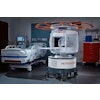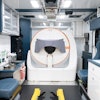
Hosting the 2004 Olympic Games has given Greece an opportunity to highlight its proud heritage and accomplishments for the world to see, and the handling of the Polyclinic healthcare facilities at the Olympics gives Greek radiology an opportunity to shine as well.
Perhaps no one is enjoying the excitement more than Professor Dimitrios Kelekis, who practically embodies the history and future of radiology in Greece.
The 66-year-old Kelekis is chairman of radiology at Eugenidion University Hospital in Athens and chief of imaging services at the Polyclinic. He graduated from the Aristotle University of Thessaloniki Medical School, Greece, and did his residency in Geneva, Switzerland.
Kelekis is also a father and uncle to several other radiologists in Greece. His family has three generations of radiologists, as Kelekis is also the son of a radiologist.
In fact, Kelekis was practically baptized into the field. One of the godparents at his baptism was his father's teacher, Dr. Demetrios Chilaiditi, who in 1910 identified the subphrenic interposition syndrome that bears his name.
Kelekis is himself a pioneer of interventional radiology in Greece. He was the first in the country to perform a variety of procedures, including the first coronary angiographies in 1970 and the first angioplasty in 1980.
Still, his volunteer position heading up the imaging services for the Olympic Polyclinic is a particularly proud moment.
"For me it was a very nice thing, because only once in our life can we have the possibility to participate, to offer to our country such efforts, keep a good scientific level, and offer yourself and your knowledge for the Athenians and for the Olympics," Kelekis said in an interview with AuntMinnie.com.
"I am very proud and happy for these efforts for me, and for all my family, and for all my collaborators," he said.
Not that Kelekis has a lot of time to savor the moment, as he has been rushing around among three facilities to perform his regular duties and work for the games.
Kelekis is also chairman of radiology at the Onassion Cardiosurgical Centre in Athens, so he's splitting his time as usual between there and the university hospital, while adding in visits to manage the imaging department at the main Polyclinic located in the Olympic Village.
Eighty percent of the radiologists and technologists serving as Polyclinic volunteers are staff members from Kelekis' department at the university hospital. They are working primarily in two shifts: five radiologists are at the Polyclinic from 8 a.m. to 4 p.m., overlapping briefly with five radiologists on the 3 p.m. to 10 p.m. shift. A solo technologist is onsite for the urgent overnight imaging.
The Polyclinic is there to serve a short-term population of up to 25,000 athletes, coaches, trainers, and other participants in the games. It opened its doors two weeks prior to the start of competition, allowing it to build up speed on a smaller population of early arrivals.
"A lot of people were really enthusiastic, and they are coming already, bringing their athletes, and asking for things," Kelekis said. "We are very proud that it is really a unique Polyclinic, and especially the radiology department is excellent."
And although international dialogues are standard fare for Kelekis -- he has served as president of the Cardiovascular and Interventional Radiological Society of Europe (CIRSE), and is currently chairman of the Foundation for Interventional Research and Education (FIRE) -- he is still happy to report the positive impressions from the latest visitors to Greece.
"I have to confess to you that yesterday came the Brazilians, the Australians, the English, the Americans, all from the medical staffs ... they said that over the years, that this one is the best medical installations, the Polyclinic, that they have ever seen," he said.
By Tracie L. Thompson
AuntMinnie.com staff writer
August 15, 2004
Copyright © 2004 AuntMinnie.com


















